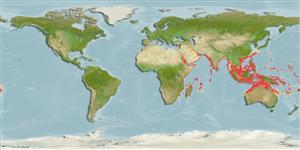Common names from other countries
>
Eupercaria/misc (Various families in series Eupercaria) >
Caesionidae (Fusiliers) > Gymnocaesioninae
Etymology: Gymnocaesio: Greek, gymnos = naked + Latin, caesius, bluish-grey, 1835; it is the same name given to the silvery metal (Cs) (Ref. 45335).
More on author: Bleeker.
Environment: milieu / climate zone / depth range / distribution range
Ecologia
marino associati a barriera corallina; non migratori; distribuzione batimetrica 0 - 500 m (Ref. 402). Tropical; 31°N - 30°S, 32°E - 177°W (Ref. 402)
Indo-West Pacific: Red Sea and East Africa to Fiji, north to the Philippines.
Size / Peso / Age
Maturity: Lm ? range ? - ? cm
Max length : 18.0 cm TL maschio/sesso non determinato; (Ref. 402)
Spine dorsali (totale) : 10 - 11; Raggi dorsali molli (totale) : 14 - 16; Spine anali: 3; Raggi anali molli: 11 - 13.
Inhabits coastal areas around coral reefs (Ref. 30573). Feeds on zooplankton in large midwater aggregations. Forms schools with members of the genus Pterocaesio. Oviparous, with numerous, small pelagic eggs (Ref. 402). Often mistaken for juveniles and easily overlooked because of small size (Ref. 48636). Also caught with drive-in nets. Utilized as tuna bait fish (Ref. 30573).
Life cycle and mating behavior
Maturities | Riproduzione | Spawnings | Egg(s) | Fecundities | Larve
Carpenter, K.E., 1987. Revision of the Indo-Pacific fish family Caesionidae (Lutjanoidea), with descriptions of five new species. Indo-Pac. Fish. (15):56 p. (Ref. 1723)
IUCN Red List Status (Ref. 130435)
CITES (Ref. 128078)
Not Evaluated
Threat to humans
Harmless
Human uses
Pesca: scarso interesse commerciale; esca: usually
Strumenti
Special reports
Download XML
Fonti Internet
Estimates based on models
Preferred temperature (Ref.
115969): 15 - 27.8, mean 23.6 (based on 824 cells).
Phylogenetic diversity index (Ref.
82804): PD
50 = 1.0000 [Uniqueness, from 0.5 = low to 2.0 = high].
Bayesian length-weight: a=0.01122 (0.00514 - 0.02450), b=3.04 (2.87 - 3.21), in cm Total Length, based on all LWR estimates for this body shape (Ref.
93245).
Trophic level (Ref.
69278): 3.4 ±0.45 se; based on food items.
Resilienza (Ref.
120179): Alto, tempo minimo di raddoppiamento della popolazione meno di 15 mesi (Preliminary K or Fecundity.).
Fishing Vulnerability (Ref.
59153): Low vulnerability (10 of 100).
